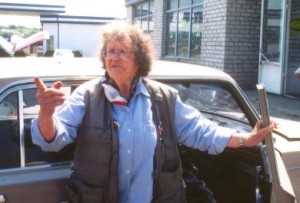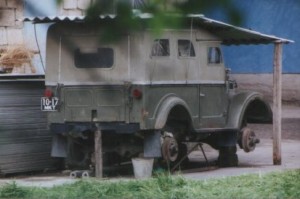Born on July 19, 1919, Marie-Jeanne Koffmann, passed away on July 11, 2021, in Paris, just short of her 102nd birthday, reports Igor Bourtsev and French hominology sites. Koffmann was a dedicated fieldworker and chronicler on the Almasty. The Almasty (sometimes termed the Kaptar) are the wild hominids reported from the Caucasus, the mountainous range that sits on the intersection of Europe and Asia, stretching from the Black Sea to the Caspian Sea.

Hominologist Dr. Marie-Jeanne Koffmann was most recently named The Cryptozoologist of the Year 2020 by the International Cryptozoology Society / International Cryptozoology Museum for her years of dedicated work in the field.


The strong spirited Dr. Koffmann has been a major force in Russian-French Hominology.
Only infrequently do we know of one of our peers who has achieved so very much in terms of hominological research (in her case, research and fieldwork on the Almasty) and lived so long.
She lived in Paris, in a home, Gautier Wendelen (below), for the elderly, in recent years.

Born in France, Koffmann spent most of her life in the Soviet Union, as a surgeon at Moscow hospitals and a mountaineer. She became interested in the “Snowman” mystery in the 1950s, particularly in Kabrarda (Caucasus), where she recorded hundreds of sightings of the almasty, the local variety of the Almas.



From 1948 to 1954, Koffmann was held in a gulag (Soviet labor camp) after being accused of spying for the French. Four years after her release, she was picked to be on the Soviet Union’s first official expedition to the Pamirs. She was the doctor of the Pamirs Academy of Sciences Snowman Expedition, in 1958. She published a synthesis of her fieldwork and research in the journal Archeologia.


Official logo of the 1992 expedition.
The results were published:
Koffmann, Marie-Jeanne. 1991. “L’ Almasty, yeti du Caucase.” Archeologia. 269. pp. 24-43.
Koffmann, Marie-Jeanne. 1992. “L’ Almasty, mode de vie d’un hominide.” Archeologia. 276. pp. 52-65.




Koffmann’s off-road vehicle “Gasik” ~ after more than thirty years of fieldwork ~ ended its working life and was taken apart. (Sarmakovo, Kabardino-Balkaria, Summer 1999).
Greenwell: What first got you interested or involved in this question of unknown hominoids? What motivated you, and when did it happen?
+++
Koffmann: It was in 1957, when I first saw an article in the Soviet press entitled “What Is the Snowman?” It told about some of the first expeditions. The article consisted of comments by eight mountain climbers whom I knew, half of whom thought the whole idea was impossible. The other half thought that there might be something to the reports.
+++







+++
Igor Burstev wrote me on June 10, 2020,
“She lives in a hostel in Paris, France. I visited her last February [2020], she in satisfactory health state, though very weak, half paralyzed, only laying down on her bed. But in a clear mind. I made a photo of her there, but it’s not nice one? she was sitting in the bed, with me next to her.






Almasty Researcher Dr. Marie-Jeanne Koffmann Celebrated Her 100th Birthday
on July 22, 2019
She lives in Paris, in a home, Gautier Wendelen for the elderly.
Born in France, Koffmann spent most of her life in the Soviet Union, as a surgeon
at Moscow hospitals and an amateur mountaineer
Durng WWII she was guiding the Red Army’s troops in Caucasus’ gorges in their
actions against fascist troops of invaders.
Anyway, from 1948 to 1954, Koffmann was held in a Gulag (Stalin labor camps)
after being accused of spying for the French without any evidence, just for her
French origin. In 1958, after having been aquainted with Prof. Dr. Porshnev she
was picked to be on the Soviet Union’s first official expedition to the Pamirs. She
was the doctor of the Pamirs Academy of Sciences Snowman Expedition.
When after many reports about sightings in Caucasus had been published by
newspapers, she set up the base of the Voluntary Expedition in Sarmakovo,
Kabardino-Balkaria Autonomous Republic, and for fifty years had headed it.
She had established the Russia’s Cryptozoologists Society, based on the State
Darwin Museum in Moscow, and headed it for decades.
As results of her activities she published a synthesis of her fieldwork and research
in the journal Archeologia, in some Soviet magazines.
+++
In 1988, in the The ISC Newsletter, Summer 1988 Vol. 7, No 2, Richard Greenwell
published his interview with Koffmann. She tells of what lead to her interest in
the topic:
Greenwell: What first got you interested or involved in this question of unknown
hominoids? What motivated you, and when did it happen?
Koffmann: It was in 1957, when I first saw an article in the Soviet press entitled
“What Is the Snowman?” It told about some of the first expeditions. The article
consisted of comments by eight mountain climbers whom I knew, half of whom
thought the whole idea was impossible. The other half thought that there might
be something to the reports.In March 1999, Dmitri Bayanov and Koffmann represented the Russian Society of
Cryptozoology at the World Cryptozoological Conference in Rome and both read
papers.
She had left Russia for France in 2009, being 90 years old, for treatment, and
stayed there in Paris till now.
Our very best to Dr. Marie-Jeanne Koffmann, who despite medical difficulties,
hits the Century mark on July 22, 2019.Koffmann, Marie-Jeanne. 1991. "L'Almasty, yeti du Caucase." Archeology . 269.
pp. 24-43. Koffmann, Marie-Jeanne. 1992. "The Almasty, a way of life of a
hominid." Archeology . 276. pp. 52-65
Koffmann’s off-road vehicle “Gasik” ~ after more than thirty years of fieldwork ~
ended its working life and was taken apart. (Sarmakovo, Kabardino-Balkaria,
Summer 1999).
Founders of Hominology (1968): Boris Porchnev, Alexander Mashkovtsev, Piotr
Smoline, Dmitri Bayanov, Marie-Jean Koffmann
Official logo of the 1992 expedition.
My First Expedition – with M.-J. Koffmann, 1965
After the unsuccessful 1958 Pamir Expedition, the North Caucasus became the
main region of searches for the “snowman.” Marie-Jeanne Kofmann’s expedition
worked there for decades. Her headquarter was based in the settlement of
Sarmakovo on the Malka river in Kabardino-Balkaria, an Autonomous Republic in
the Russian Federation. The creature in question is called – (there only!) almasty,
sometimes kaptar. Later on Jeanne had written a big article about the almasty’s
ecology, ethology, habituations etc., having analyzed a lot of eyewitness reports,
gathered in that location.
I joined Koffmann’s expedition in the summer of 1965 together with my first wife
Alexandra Burtseva (late). At that time I had just changed my job: after having
graduated from the Moscow Aviation University, I worked as an engineer in one of
designer’s office in space technology (as Alexandra did too), but after coming that
my vacation I had to start my job as an officer in a district division of the Youth
Leage (Komsomol).
Thus during our vacations we travelled to the Caucasus region. Local people knew
about almastys’ existence, and even the owner of the house, where Jeanne resided,
had encounters with such creatures in the past. The information collected there
within one month testified to the reality of almastys’ existence.
One report impressed me especially.
Once some people came to our head-quarter, and being extremely agitated,
narrated to us, that one woman from the Konezavod (Horse Farm) settlement had
met almasty just a couple of days before, and now she was ill because of shock.
With another participants, we jumped into Jeanne’s micro-car and rushed to that
settlement. We had found the woman-eyewitness, and she narrated the following.
She was in a ravine, cutting branches and brushes with an axe for firewood.
Suddenly while cutting the next brush, her glance caught behind the limbs
somebody’s hand with stirring fingers. She raised her head and saw behind the
brushes somebody’s muscled hairy hands, then a powerful breast also covered with
thick black hair, a low seated head with red eyes. And as she told us, “when my
eyes met with his red eyes stearing directly at me, I got down powerless to my
knees”. After several seconds, her mind came back to her and she thought: “I have
an axe, I can defend myself” – and her power came back to her. She stood up
slowly and stepped back, then, not turning her back to the creature, retreated down
the slope of the ravine. After having left the horrible site, she ran to her home, and
afterwards felt herself ill.
The information gathered by us at that month was so impressive and convincing,
that the search for hominoids has become ever since the main goal of my life. In 50
years that have passed since then, I changed several professions and finally became
editor and director of Cryptologos – a small private publishing firm in Moscow (set
up in 1992). But all along this time, and whatever positions I got, I have alwaysremained a hominologist. At every opportunity I engaged in the search and
investigation of homins. So it is possible to say that my basic and constant
speciality has been hominology.
And in 2003 we set up the "Cryptospere" Fund for Furthering Scientific
Researches and Searces, and under it – The International Center of Hominology,
I'm the head of.
Captions:
4-1 Jeanne Koffmann
4-2 M-J with Dmitri Bayanov in burcas
4-3 Jeanne’s group of voluntaries (on right) with house owners’ family (on left) in
the yard of the head-quarter
4-4 Repairing the small car with an assistant – a member of expedition
4-5 the local woman’s encounter, 1965. Drawing by Lidiya Burtseva
4-6 One of the footprints found and casted by Jeanne Kofmann group in 1978,
4-7 So big was a stride of a creature left the foot prints
4-8 M-J.K. in 2009 in a forest before leaving for France. Credit by Dmitry Pirkulov
+++
For more on hominology and cryptozoology
visit the International Cryptozoology Museum
and support our nonprofit mission via the CryptoStore.
Donate here. Thank you.

Follow CryptoZooNews
Not Found
The resource could not be found.